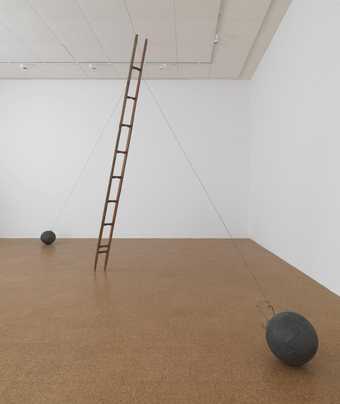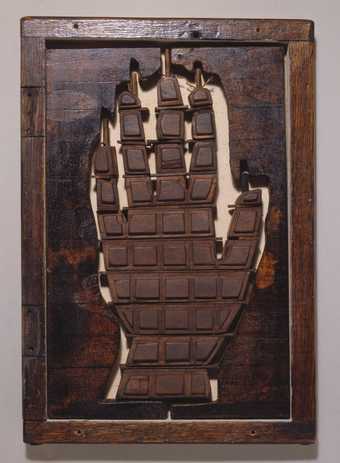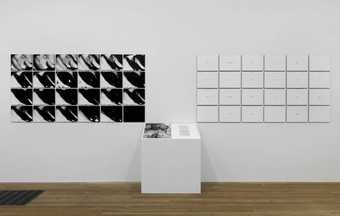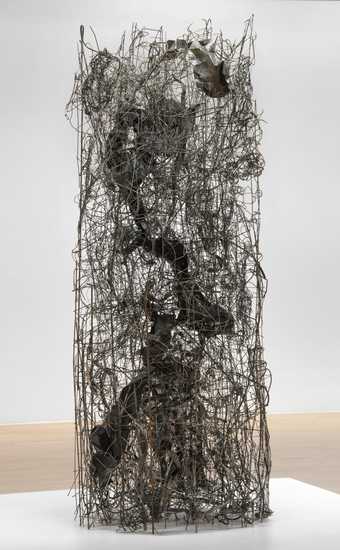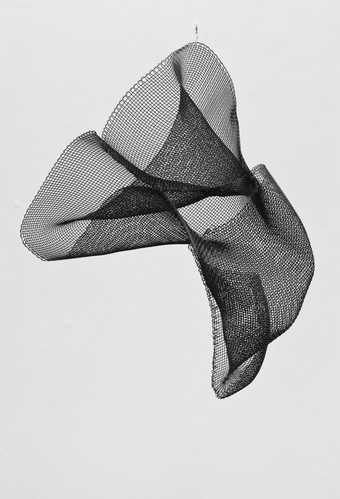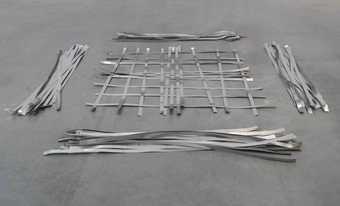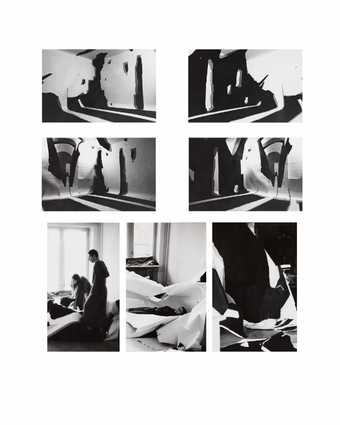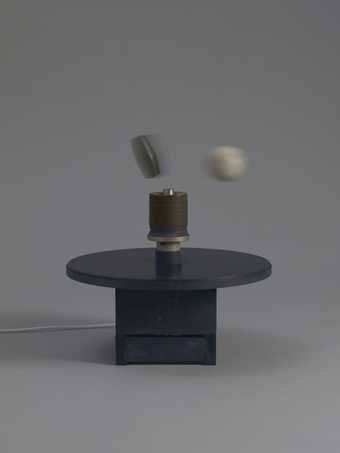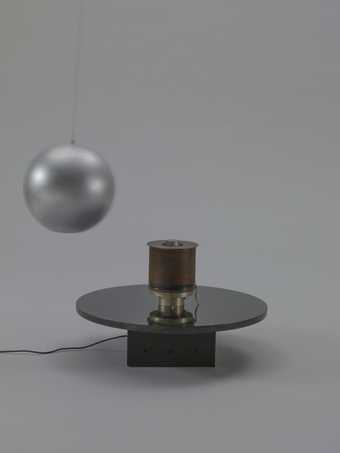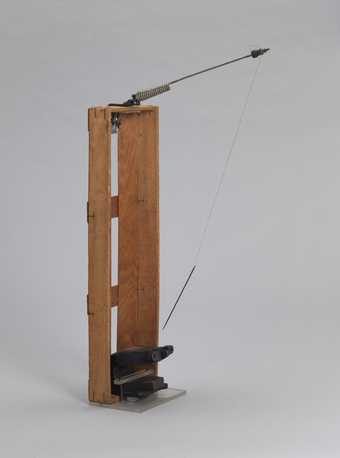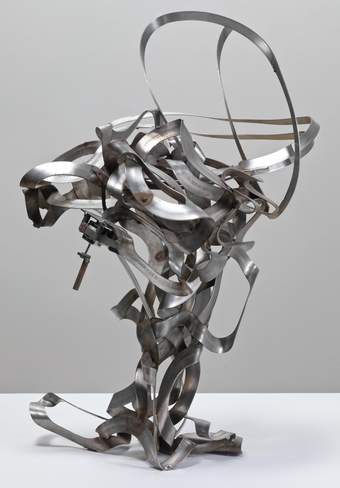In Tate Modern
- Artist
- Ana Lupas born 1940
- Medium
- Steel, straw, wire mesh and 2 digital prints on vinyl
- Dimensions
- Unconfirmed: 6000 × 6000 mm
- Collection
- Tate
- Acquisition
- Purchased with funds provided by the Russia and Eastern Europe Acquisitions Committee and Tate Members 2016
- Reference
- T14526
Summary
The Solemn Process 1964–2008 is a large-scale installation comprising twenty-one unique metal sculptures of varying dimensions and forms, as well as two large wall vinyls, each displaying a grid of forty sepia-toned images. It was created over a period of five decades by Romanian artist Ana Lupas. The photographs feature a series of straw objects in rural, agricultural settlements. Some of the images are also populated by people who interact or pose with them. The objects in the photographs are the same shape as the metal sculptures, suggesting that there is a direct relationship between them despite the different materials and their presence in the gallery. Indeed, the two vinyl panels and the sculptural objects can be seen as discrete elements that directly relate to the three phases in which the work was made: the first between 1964 and 1974 and into 1976, the second between 1980 and 1985 and the third between 1985 and 2008. These three phases relate to the changing social and political situation in Romania.
For the first phase Lupas collaborated with villagers in rural Transylvania to produce cylindrical and circular shaped wreaths. The wreaths were made using traditional rural techniques and materials such as straw and clay, usually employed for the construction of houses and fencing. The objects were created without any practical function, with the tall cylindrical columns varying in height from just under one-and-a-half metres to over eight metres high and the largest circular form measuring over two metres. Local participants were invited to display the structures in the environment, installing and arranging them both in the landscape and in their homes. The arrangements were then documented photographically. The work was supposed to develop over time, involving more participants who would make more objects, expanding the artwork as a collective.
By the early to mid-1970s the restrictive political climate and worsening economic situation in communist Romania made it difficult for rural participants to continue engaging in the process and the production of new sculptures ceased. Lupas also realised that objects left in situ were gradually decaying. As such during the second phase, from 1980 to 1985, she attempted to restore the original wreaths. The artist commented that: ‘This period could be considered as a distressing and dramatic one, but it enriched a failed concept and led to finding new ways to get back to the original concept’ (Lupas in email correspondence with Tate curator Juliet Bingham, 19 January 2015). Finding the restoration process unsatisfactory in relation to the original concept of the ‘infinite dimension of the installation’ (Lupas to Bingham, 19 January 2015), Lupas sought an alternative method of extending the life of the work. In the third and final phase, from 1985 to 2008, the ephemeral objects were ‘preserved’ by encasing them in metal forms. Hungarian craftsmen were commissioned to fabricate the metal containers using traditional metalwork techniques, mirroring the individual shapes of each original wreath. For the artist this transformation, or ‘re-making’, was a deliberate process of re-evaluating the work.
The title The Solemn Process refers to a traditional Romanian ritual relating to the harvesting of crops. However, it can also be read in relation to Lupas’s artistic practice more broadly, particularly her interest in the development of artworks over a long period of time. Curator and historian Ileana Pintilie has described this approach:
The ‘process’ consists of as large a space as possible, usually variable, which can be extended infinitely – amplification of the time element suggesting an indefinite prolongation of the ‘process’. Based on the two variable elements [space and time], this characteristic in fact gives birth to a progression – a development of the action which, symbolically, may be endlessly prolonged.
(Pintilie 2002, p.39.)
Following the completion of the three phases, The Solemn Process was exhibited at Taxispalais, Innsbruck, in 2008. The metal objects were gathered together in the centre of the gallery in a space measuring approximately eight by ten metres, while the vinyl banners extended up the interior and exterior wall of the gallery, broken by a glass ceiling. The Solemn Process can be seen in relation to Lupas’s other long term work Humid 1966. This action in the landscape, which took place in Margau, Transylvania, was reimagined by the artist as The Flying Carpet, A Symbol of Peace 1973 in Paris, Process of Determination 1977 in Angers and through the subsequent decades. Both Humid and The Solemn Process exemplify Lupas’s interest in folklore, ritual and agricultural labour as well as her exploration of land art.
Further reading
Magda Cârneci and Irina Cios (eds.), Experiments in Romanian Art Since 1960, exhibition catalogue, Soros Center for Contemporary Art, Bucharest 1997.
Ileana Pintilie, Actionism in Romania during the Communist Era, Cluj 2002, pp.39–41.
Ramona Novicov, ‘Three Female Hypotheses of the Romanian Avant-Garde’, in n.paradoxa, no.20, April 2008, pp.43–50, http://www.ktpress.co.uk/pdf/nparadoxaissue20, accessed 21 February 2015.
Juliet Bingham
February 2015
Does this text contain inaccurate information or language that you feel we should improve or change? We would like to hear from you.
You might like
-
Joseph Beuys Scala Napoletana
1985 -
Alexander Calder Antennae with Red and Blue Dots
c.1953 -
Robert Adams Space Construction with a Spiral
1950 -
Paul Neagu Full Hand
1970–1 -
Luis Camnitzer Sentences
1966 -
Julião Sarmento Untitled (Bataille)
1976 -
León Ferrari Tower of Babel
1963 -
Katsuhiro Yamaguchi Mesh sculpture
1961 -
Lee Ufan Relatum
1968, 1994 -
Irina Nakhova Room no. 2
1984 -
Stephen Willats Contemporary Living
1986 -
Takis Magnetic Ballet
1961 -
Takis Magnetic Ballet
1963 -
Takis Defying Gravity
1965 -
Feliza Bursztyn Untitled
1968


